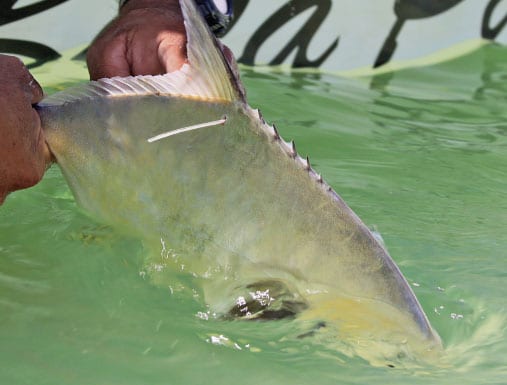Permit have the uncanny ability to look like anything an angler might encounter on the flats. If you’ve ever pursued them, no doubt you have launched a hero cast to a feeding fish, crouched down and then stripped with intent only to realize your target wasn’t a fish at all. However, when an actual permit does appear, something happens inside of you. Your blood begins to run fast, your knees begin to quiver, and everything on your mind disappears — everything except that fish. Permit rank as one of the most special species a fly-angler will ever come across, and all around the globe, they completely live up to their elusive, finicky and wise reputation.
This has attracted fly-anglers since the beginning of the sport, and even though many years have passed since that time, we still don’t know much at all about this great fish. But thanks to a brand-new tagging effort initiated by Bonefish & Tarpon Trust and backed by Costa Sunglasses, valuable data has started to trickle in that will help us better protect the flats species that we love to hate. Project Permit is in full effect.
When people become stressed or need an escape, many go fly-fishing, myself included. While I can’t think of a better remedy to the aliments that hit us all at one time or another, I don’t think you necessarily have to be actually on the water to receive the curing effects. For example, when I’m unable to make it to the coast, I can always sit back, close my eyes and reflect on various experiences that will never escape my mind. Fortunately, I have a pretty good bank of happy thoughts, but in all honesty, the one that I refer to most often is the very first time I saw a permit in person. That unmistakable black tail slowly broke the surface and inched forward almost like the dorsal fin of Jaws in the popular ’80s film. It then stopped, protruded from the water to indicate the fish was standing on its head and began to violently flick as
the fish rooted into the hard sand to suck in the crab or shrimp it found for a meal. From that point on, I was addicted to permit. That was years ago, and though I’ve not caught one, permit are still my favorite fish to target.
I first heard of Project Permit through BTT’s director of operations, Dr. Aaron Adams. At the time, I assumed there were already efforts in place to gain data on the species, but after reading the original release I received about the program, I was shocked to find out that, up until this point, virtually no data had been collected on the species. While I consider myself a conservation-minded angler, I don’t claim to be a conservationist, but even still, the first question I had was, “How can we possibly successfully manage a species based on nothing?”
Not long after learning about the program, I was asked to accompany Adams and Al Perkinson, of Costa Sunglasses, to Mexico’s Yucatan Peninsula to participate in the project. I admit, my initial reason was slightly self-serving — six days of permit fishing in one of the world’s most likely permit haunts, pretty good odds. However, like many fly-fishing treks, the trip quickly became about much more than simply putting a hook in my white whale.
The three of us met at the Cancun, Mexico, airport, and after a quick bite of breakfast washed down with a couple of Coronas, we boarded a tiny plane and made our way to our first stop — Isla Punta Pajaros. It is home to one of the oldest fly-fishing lodges in the whole Yucatan, Casa Blanca, which is where we would conduct our “research” the next four days. Upon our arrival, Rita Adams and Johnny Pares greeted us at the dock with warm towels and margaritas. The three of us were itching to put our crab patterns to the test, so we quickly rigged up and made our way out for an afternoon session. At this point, we all wanted to catch permit, but for different reasons. Aaron and Perkinson were eager strictly from a data standpoint, but me — well, I wanted bragging rights. The afternoon was overcast and windy, which would make spotting fish and presenting flies tricky. We had only a few hours, but the time went extra fast, as it often does when you are fishing, and all we managed were a few small bonefish.
We awoke the next morning to similar conditions, and Rita and Pares wished us luck and sent us out into Ascension Bay, very well one of the best places on the planet to target permit. Just like most guides in the region, the Casa Blanca captains don’t say much — their eyes remain fixed on the water in
front of them, and little to nothing can distract them. On this day, Aaron was on his own, and I was sharing a boat with Perkinson. In no time at all, an obvious push became apparent about 100 feet away. It was two permit moving very fast. Perkinson made several shots but could not divert the fish from their route. This was to be the case for the remainder of the day. Pole a little bit, spot nervous moving water, make the shot, and nothing. Since I’d never caught one of these fish, catching even a small one would have been fine by me. However, the fact that nearly every fish we saw out of Casa Blanca was 20 pounds or more made me even more nervous.
For years I have read about the famed Casa Blanca, and after one day, it was clear why this lodge has received so much ink for so long. The habitat was unlike any I have seen before. You have open water surrounded by mangrove mazes, ledges and shallow flats, and bonefish, tarpon, snook and permit can be found in nearly all of them. During our stay, we focused on the deeper open-water bays. Rita and Pares said permit found in areas like this tend to eat a little better.
I was amazed at how many fish we came across each and every day. I had the pleasure of riding along with Perkinson and Aaron and also tagged along with Rita one day. Every morning and afternoon, we had great shots at giant permit. I wouldn’t have guessed in a million years that a fish would have passed up some of the casts I witnessed. But once again, we were pursuing permit. After a few days of striking out, I became less concerned with saying I caught one and more focused on accomplishing the mission at hand — tagging one so that someday another angler could catch it again and feed the data to the appropriate scientists, who will ultimately help us protect the species.
As easy as it would have been to stay at Casa Blanca, we had a schedule to keep and were transported across Ascension Bay to Punta Allen. From there, we drove north to try our luck at Boca Paila, near the town of Tulum. Once we were on location, the three of us rerigged and made arrangements for an afternoon session. Just like after our maiden voyage out of Casa Blanca, we came back to the lodge empty-handed.
At this point, we felt the pressure, yet none of us were overly surprised. Our experiences could be considered expected when it comes to targeting what many think is the most difficult fish to deceive with a fly. As Adams said while we chatted back at the lodge, referencing an Einstein quote, “Doing the same thing over and over again and expecting a different result is the definition of insanity — it’s also the definition of permit fishing.”
The next morning, I fished with Perkinson once again, and our luck was the same, but when we finished, Adams was already back, and he had a suspicious smirk on his face. The smirk became a big smile when he began showing us shots of a small permit that fell victim to his Rag Head Crab. It was a small fish, but it was in fact a permit, and he’d successfully tagged it. Even though Perkinson and I were permitless, we shared Adams’ happiness. It felt as though we had all succeeded and contributed to the cause.
One successful permit tag in, we all set out the next day with a confidence boost, but yet again, our quarry didn’t want to play ball.
To get a bend in the rod, Perkinson and I decided to look for bonefish. What I found interesting (and admired) at both Casa Blanca and Boca Paila was how much the guides wanted to catch permit. Even though they could easily put their clients on bonefish, snook or tarpon and stand a much better chance of catching fish, they’d rather not. At our suggestion to search for bones, our guide said, “OK, we move to find bonefish.” But once we changed spots, I noticed that we were not in super shallow water at all; in fact, it was just as deep as where we’d been fishing. Perkinson asked our guide, “What do you think — switch to a Gotcha?” Without taking his eyes off the water, he replied, “No, leave the crab.” It was obvious he was still searching for permit. Perkinson and I had a laugh, continued fishing and chatted a little bit about Costa’s involvement in the project. Costa has always prided itself on being forward-thinking and participating in aspects of fishing that will make a difference. Perkinson and I agreed that the Yucatan is such a beautiful place and just an incredible resource that genuinely needs to be protected. Perkinson told me, “Lodges like Casa Blanca and Boca Paila are the founders and pillars of conservation in this region. Project Permit is meant to bring resources to the region that will protect not only permit but also the habitat in which they live. This region is such an important place not only to us, but also to our customers and fishermen as a whole. This is Costa’s way of giving back, and it makes me feel good to play a small part in protecting such a great fish and such an outstanding fishery.”
With one day left to fish, I decided to join Adams and see if lightning could strike twice. With only one permit to our credit after five days of fishing, the trip might sound like an epic failure, but to me, it was a battle won. We accomplished what we set out to, and anything more would have been gravy. Just like every day before, we were on fish early and managed to stay on them for the majority of the day, but once again, they were being difficult. Our guide poled us along one final shoreline to see if we couldn’t squeak out one more. As we searched, I quizzed Adams about the project. He reported the effort had already been a huge success: “In the short time Project Permit has been in place, about 140 permit have been tagged and are swimming around Ascension Bay. Once they are recaptured, we will be able to find out extremely valuable information, including spawning areas, nurseries, migration habits etcetera, etcetera. Because an actual study hasn’t been conducted until now, it’s hard to say exactly what we will find — it’s exciting!” And the fact that the program is driven by the guides and lodge staff as a means to learn more about the fish and fishery that they love is a breath of fresh air. Nobody involved is interested in tagging fish to boost their ego or promote their business. Project Permit began in Florida and has expanded into Mexico and Belize. Adams said that the permit fishing in these areas and the Caribbean brings in hundreds of millions of dollars each year. It was so gratifying to see that the guides and managers of Casa Blanca and Boca Paila recognize this and understand why it is so important to be a part of the project.
Our conversation was interrupted by our guide, who’d spotted a group of three fish cruising along a deep edge of the flat. Adams quickly forgot about me and began scanning to find them. When he did, he unrolled a nice cast in the stiff wind, and the fish scooted by. Three more tries, and he managed to pull one off of its course. I held my breath and thought, “What a perfect end to a great trip it would be if this fish ate.” As he stripped, I closed my eyes, opening them when I heard him yell, “It’s about $*#&#*$ time!” He played the fish to the boat and transitioned into scientist mode. He measured and tagged the fish in textbook fashion and sent it on its way. As the tired fish swam away, I couldn’t help but smile and think how cool it would be if the first permit I found on the end of my line had a piece of jewelry in the form of a tag.
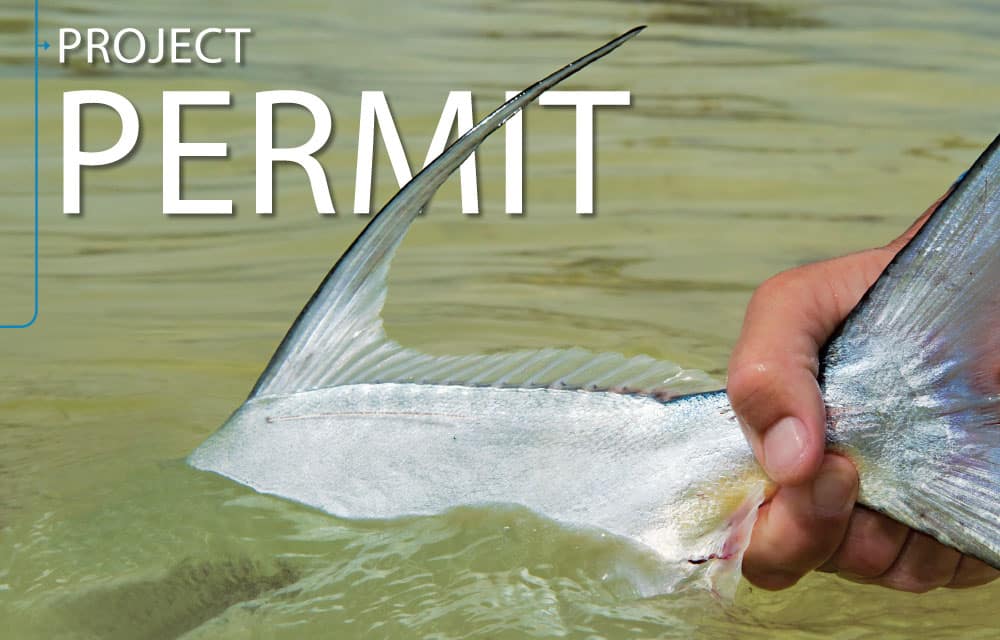
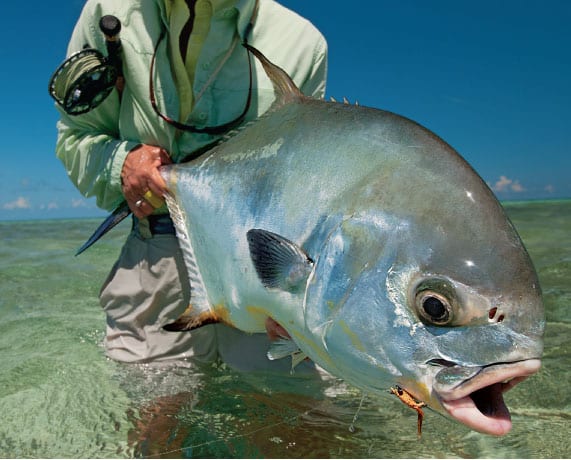
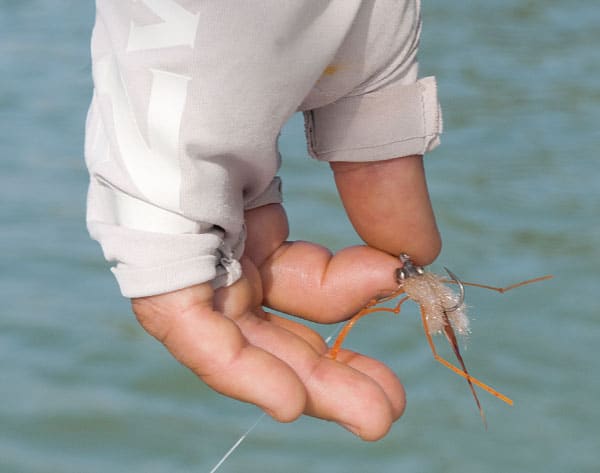
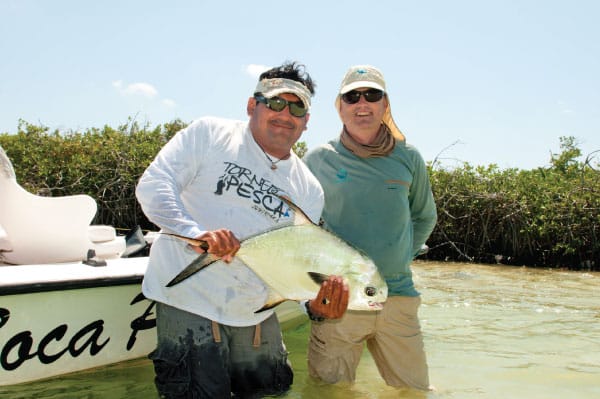
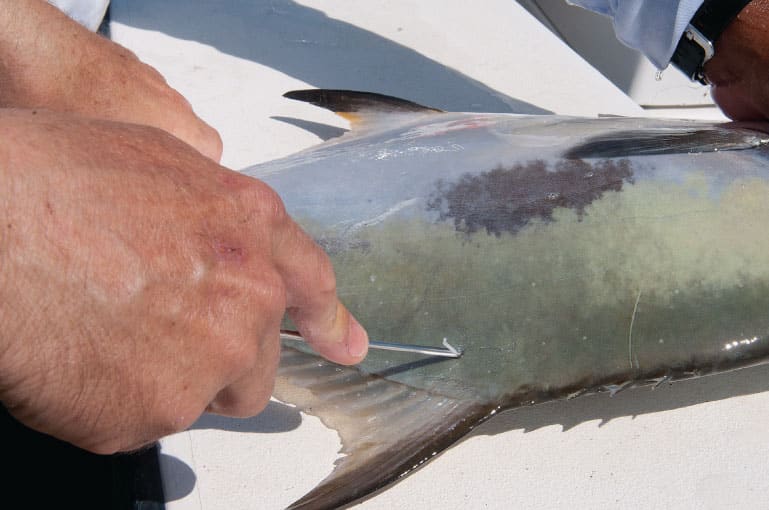
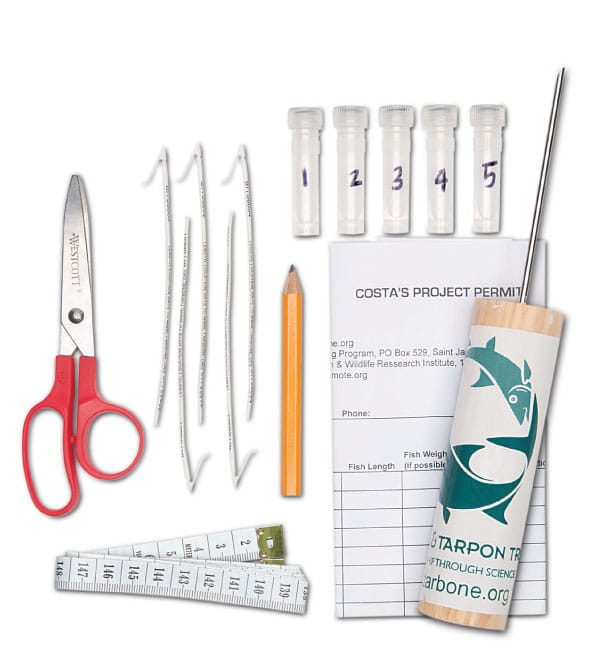
Permit Tagging Kit
